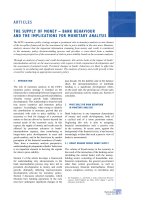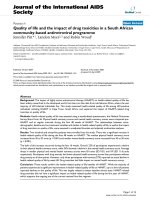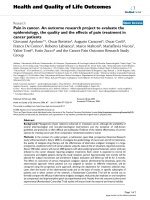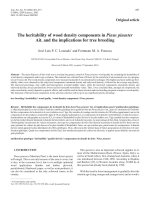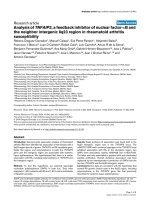Repeat polymorphism analysis for examning genetic variablility and the implications for specific traits in dog breeds
Bạn đang xem bản rút gọn của tài liệu. Xem và tải ngay bản đầy đủ của tài liệu tại đây (397.82 KB, 6 trang )
Genes Genet. Syst. (2013) 88, p. 273–278
Repeat polymorphism analysis for examining genetic
variability and the implications for
specific traits in dog breeds
Jungwoo Eo and Heui-Soo Kim*
Department of Biological Sciences, College of Natural Sciences, Pusan National University,
Busan 609-735, Republic of Korea
(Received 23 October 2013, accepted 6 January 2014)
Genetic variations of functional genes in various animal species have been previously examined to understand the relationship between genotypes and phenotypes. Repeat polymorphism can be found in not only coding sequences but also
untranslated regions of the protein-coding genes, affecting gene regulation via a
variety of mechanisms. In this respect, repeat polymorphisms including microsatellites, variable number of tandem repeats (VNTRs), and short interspersed
nuclear elements (SINEs) in relation to functional genes contribute to recognition
of genetic or phenotypic variation and individual identification. These elements
are biologically valuable markers for studies on association between genetic makeup and behavioral patterns in dog breeds. Hence, to examine the effect of genotype on behavior, studies on this combination are certainly important. Hence,
this review could cast light on the functional roles of repeat polymorphisms in dog
behavior and breed variation.
Key words: dogs, functional genes, microsatellites, short interspersed elements
(SINEs), variable number of tandem repeats (VNTRs)
INTRODUCTION
Genetic variation in functional genes has been a focal
point for understanding the relationship between genotypes and behavioral phenotypes in various animal
species. Genetic variation plays a significant role in the
development of inherited features and the evolution of
domestic breeds. With respect to phenotypic diversity,
the dog is ranked as the most unique domesticated animal (Parker et al., 2004). Single-locus SNP analysis of
the genetic relationships among dog breeds indicated that
the consensus tree clearly supported the basic division
between wolves and domestic dogs (vonHoldt et al., 2010).
However, the classification of breeds into functional and
phenotypic groups is not true of all breed groupings. In
order to solve this problem, an approach for genetic identification of multifactorial traits was employed, involving
an association analysis of candidate genes in dog populations.
Repeat polymorphism in genes is associated with
diverse phenotypes by influencing the gene function.
Analysis on the repeat polymorphism leads us to identify
differences between various dog breeds based on genetic
Edited by Yoko Satta
* Corresponding author. E-mail:
diversity. It can also help us to understand the relationship between genetic features and behavioral phenotype
in dogs. Dynamic potential of repeat polymorphism in
dog as well as human have been well studied. Among
repeat elements that are classified based on their structure and size of repeat unit, microsatellites in mammalian genomes consist of the simplest tandem repeats of
short units, which could be effective genetic markers for
dog breed phylogeny, genetic variation, and quality control (Irion et al., 2003; Ellegren, 2004). An investigation
of the trinucleotide (CAG) repeat encoding glutamine in
exon 1 of the androgen receptor (AR) gene indicated that
polymorphisms of the CAG microsatellite are associated
with aggression in Japanese Akita Inu (Konno et al.,
2011). A relatively short CAG repeat sequence enhances
the transcriptional activity of AR by promoting the interaction between the receptor and co-activator (Chamberlain
et al., 1994).
In addition, an association study between behavior and
a repeat polymorphism in intron 2 of the canine dopamine
receptor D4 (DRD4) gene demonstrated a significant association between social impulsivity and intronic VNTRs
(variable number of tandem repeats) of the DRD4 gene in
German Shepherds (Hejjas et al., 2009). It was also
reported that a repeat polymorphism in the tyrosine
hydroxylase (TH) gene is linked to activity-impulsivity in
274
J. EO and H.-S. KIM
German Shepherds (Kubinyi et al., 2012). The VNTR
polymorphism in the DRD4, TH, dopamine β-hydroxylase
(DBH), and dopamine transporter (DAT) genes has been
investigated among four dog breeds and European Grey
Wolves in order to understand its relationship with the
activity-impulsivity phenotype (Hejjas et al., 2007).
How could the repeat polymorphism in functional genes
be associated with phenotype? The polymorphic repeat
elements could be found in coding sequence (CDS) or
untranslated regions (UTRs) of functional genes, and
have dynamic impacts on gene regulation (Fig. 1). The
repeat polymorphism can influence gene expression by
acting as a cis-element, and in mRNA processing such as
splicing and adenylation. However, the mechanisms by
which the repeat elements are involved in gene regulation
at diverse steps remain unexplored. The 5′ UTR is especially thought to be a crucial region to regulate gene
expression through various mechanisms (Chatterjee and
Pal, 2009).
Many studies in human suggest that repeat polymorphism in the 5′ UTR could have an effect on gene
expression. For example, a VNTR in promoter region
monoamine oxidase A (MAOA) gene affects its expression
by altering transcriptional activities of the MAOA promoter depending on the number of repeats in human
(Deckert et al., 1999). In case of human sirtuin 3 (SIR3)
gene, a VNTR polymorphism in intron 5 has been investigated, demonstrating an allele-specific enhancer activity in vitro (Bellizzi et al., 2005). As for studies on
relationship with splicing events, a polymorphic GT simple repeat in intron 2 of human cardiac Na+Ca2+
exchanger 1 (NCX1) gene exhibits variable length, and
acts as a strong intronic splicing enhancer that could reg-
ulate the NCX1 expression, possibly by controlling tissuespecific alternative splicing (Gabellini, 2001).
Here, we reviewed repeat polymorphisms including
microsatellites, VNTRs, and short interspersed nuclear
elements (SINEs) associated with functional genes, focusing on relationship with behavioral variation and individual identification. We further suggest application of
these tools as practically useful markers for association
genetic studies of dog breeds.
MICROSATELLITE POLYMORPHISM
AND SNP IN DOGS
Dogs play a number of important roles in modern society and are an ideal animal for elucidating the genomic
features of behavioral traits (Spady and Ostrander, 2008).
Microsatellites, tandem repeats of short units (1–6 bp in
length), tend to expand with higher copy numbers
because the length is likely to be altered during DNA replication at a higher rate than the average rate of point
mutations (Ellegren, 2004; Payseur et al., 2011; Sun et
al., 2012). Microsatellite loci could serve as suitable
markers for parentage tests and individual identification
to achieve reliable pedigree verification of dog breeds
(Kang et al., 2009). The technique using various microsatellite markers simultaneously could be a more costeffective, more accurate, and faster way to infer genetic
variation and pedigree information. As the multiplex
PCR technique is useful for analyzing multiple alleles in
dog breeds, experimental studies based on multiplex PCR
with microsatellite markers have been reported (Kim et
al., 2001; Takeuchi et al., 2005, 2009b). Genetic variability and structure in East Asian dog populations were ana-
Fig. 1. Schematic representation of gene dynamics by repeat elements (microsatellite, VNTR, and SINE) and their plausible biological
roles in functional genes. The repeat elements located in various genetic regions (exons, introns, 5′UTR, and 3′UTR) can influence gene
regulation through diverse mechanisms.
Repeat polymorphism for specific traits in dogs
lyzed by eight microsatellites, demonstrating that Korean
native dogs formed the closest groups and showed a close
relationship to the Eskimo dogs. These results indicated
that allele frequency and heterozygosity were suitable for
individual identification and paternity diagnosis (Kim et
al., 2001). Gene-associated microsatellites have been
identified. Two polymorphic microsatellites in canine
Monoamine Oxidase A (MAOA) gene, encoding a mitochondrial enzyme that degrades the neurotransmitters,
have been reported (Klukowska et al., 2004). As a point
mutation of human MAOA is associated with abnormal
behavior (Brunner et al., 1993), these polymorphisms
could be involved in behavioral changes in dogs. Additionally, a microsatellite polymorphism between canine
behavioral traits and genetic variability is expected to be
associated with some types of aggressive behavior in the
Shiba Inu (Takeuchi et al., 2009b). In the case of the solute carrier family 1 member 2 (SLC1A2) gene, the TT
genotype located in coding region was more active than
the TC or CC genotypes in dog behavior (Takeuchi et al.,
2009a). As a study for the genetic background of canine
behavioral traits, polymorphism in the TH and DBH
gene, which encode biosynthetic enzymes producing catecholamine neurotransmitters biosynthetic enzymes, were
reported (Takeuchi et al., 2005). The C97T polymorphism in TH showed CC, CT, and TT genotype, whereas
A1819G polymorphism in the DBH had AA, GA, and GG
genotype. These variable sequences were thought to
cause amino acid substitution. The C97T and A1819G
polymorphisms were found only in the Shiba Inu, suggesting that the polymorphic markers in the genes encoding catecholamine biosynthetic enzyme might be useful
for examining the genetic background of behavioral characteristics in dog breeds (Takeuchi et al., 2005).
Analysis of polymorphic trinucleotide (CAG) repeat size
(or number) in exon 1 of the AR gene indicated that male
dogs with a short allele had increased AR function and
showed higher aggressiveness scores than those with longer alleles (Konno et al., 2011). In vitro studies have
demonstrated that the human AR gene with a relatively
short CAG repeat sequence possesses enhanced transcriptional activity by promoting the interaction between the
receptor and co-activator (Chamberlain et al., 1994). The
short CAG repeat sequences seem to be related to violent
behavior and amygdala reactivity, which is involved in
threat-related cues and presentations of angry faces (vs.
happy) in human (Rajender et al., 2008; Manuck et al.,
2010).
In addition, the microsatellite polymorphism could also
act as a functional unit and interact with SNPs in the regulation of transcription. In human, an impact of microsatellite length on transcriptional activity was investigated
in the background of haplotypes (rs35767:T > C, the CArepeat microsatellite, rs5742612:T > C, and rs2288377:T >
A). As a form of T-(CA-repeat microsatellite)-C-A The
275
(CA)17 repeat microsatellite with a C-T-T haplotype in the
promoter region of the insulin-like growth factor 1 (IGF1)
gene showed relatively low transcriptional activity,
whereas the (CA)21 repeat microsatellite with a T-C-A
SNP, exhibited high transcriptional activity, suggesting
that microsatellite length variation could control gene
expression with a neighboring SNP event (Chen et al.,
2013). While this study is limited to human genome, it
demonstrates that analyses of microsatellite with SNP
allow us to understand the genetic variability in dogs.
In case of microsatellite polymorphism and SNP, little
has been known about its correlation with behavioral phenotype in dogs so far. However, the simple repeat microsatellites and SNPs have potential to be applied as
molecular markers for each dog breed or individual
identification. Gene-related microsatellites and SNPs
could also be involved in functional gene regulation that
results in different behavioral features.
VNTR POLYMORPHISM OF FUNCTIONAL
GENES IN DOGS
Dogs have recently diverged and have maintained a relatively low genetic variability as a result of artificial
selection and inbreeding. However, VNTR polymorphisms especially in neurotransmitter-related genes have
been well studied in dog breeds (Hejjas et al., 2007, 2009;
Ito et al., 2004; Kubinyi et al., 2012), and are summarized
in Table 1. Aggressive behavior in dogs is a complex
issue with various contributing aspects, including fear,
activity level, and territoriality. The DRD4 gene is
believed to play a role in brain function and may influence
affection and personality, and it is a candidate gene for
behavior disorders. For example, allelic variants of the
DRD4 gene are associated with novelty-seeking behavior
in humans (Benjamin et al., 1996). The 24 bp insertion/
deletion in exon 1 of the DRD4 gene described by Ito et
al. (2004) was shown to be polymorphic in all dogs.
VNTR polymorphism in DRD4 exon 3 (a polymorphic
region containing 39 bp and 12 bp units) was analyzed
with respect to the behavior of German Shepherds, but it
was difficult to elucidate behavior patterns (excitability,
aggression, and impulsivity) or receptor function by allele
frequencies of polymorphism (Niimi et al., 1999; Ito et al.,
2004; Hejjas et al., 2007). A study addressing the molecular functional role and behavioral association of DRD4
examined intron 2 of the canine DRD4 gene. Behavioral
analysis of 96 unrelated German Shepherds showed a significant association between the social impulsivity endophenotype of the Greeting Test and both the exonic and
the intronic VNTRs of the DRD4 gene (Hejjas et al.,
2009).
Recently, an association study was conducted between
the TH gene and the activity-impulsivity and inattention
traits in a pet German Shepherd population. Dogs were
276
J. EO and H.-S. KIM
Table 1.
Published repeat polymorphism and SNP found in the behavior-associated functional genes in dogs
Gene
Type
Location
1
Genotype
References
Exon 1
(CAG)n
Konno et al., 2011
Microsatellite
Exon 15
(TAAA)n
Klukowska et al., 2004
Microsatellite
Exon 15
(GT)n
Klukowska et al., 2004
SLC1A2 (Solute Carrier Family 1 Member 2)
SNP2
Coding region
TT/TC/CC
TH (Tyrosine Hydroxylase)
SNP
Coding region
CC/CT/TT
Takeuchi et al., 2005
SNP
Coding region
AA/GA/GG
Takeuchi et al., 2005
VNTR
Exon 1
24 bp
Ito et al., 2004
AR (Androgen Receptor)
MAOA (Monoamine Oxydase A)
DBH (Dopamine b-Hydroxylase)
DRD4 (Dopamine Receptor D4)
TH (Tyrosine Hydroxylase)
1
2
3
4
Microsatellite
Takeuchi et al., 2009a
Takeuchi et al., 2009b
VNTR
Exon 3
12 and 39 bp
Niimi et al., 1999
VNTR3
Intron 2
17 bp
Hejjas et al., 2009
VNTR4
Intron 4
36 bp
Hejjas et al., 2007
Kubinyi et al., 2012
DBH (Dopamine β-Hydroxylase)
VNTR
Intron 4
17 bp
Hejjas et al., 2007
DAT (Dopamine Transporter)
VNTR
Intron 9
38 bp
Hejjas et al., 2007
DRD2 (Dopamine Receptor D2)
SINE
Intron 6
tRNA-SINE(CA-polyA)
Jeoung et al., 2000
Correlation between this polymorphic microsatellite and aggressiveness in Japanese Akita Inu has been reported (Takeuchi
et al., 2009b).
Correlation between this SNP and aggressiveness in Shiba Inu has been reported (Konno et al., 2011).
Correlation between this polymorphic VNTR and social impulsivity in German Shepherds has been reported (Hejjas et al.,
2009).
Correlation between this polymorphic VNTR and impulsivity in German Shepherds has been reported (Kubinyi et al., 2012).
assessed by the dog owners, who completed a questionnaire, and by experts, who scored the behavior of dogs in
a battery of tests. The results suggested that a repeat
polymorphism of TH intron 4 was related to behavior in
both the questionnaire and behavioral test (Kubinyi et al.,
2012). Dogs carrying at least one short allele (a 36-bplong sequence) showed higher activity-impulsivity than
those possessing two copies of the long allele (a duplicated
form).
As shown in Table 1, the VNTR of a 17 bp segment in
intron 4 of the DBH gene was polymorphic in various dog
breeds (Belgian Tervueren, Belgian Groenandael, Belgian
Malinois, and German Shepherd) and the European
Wolf. The copy number of the 17 bp segment was either
one or three; none of the examined samples were found to
have a copy number of two (Hejjas et al., 2007). In the
analysis, 38 bp repetitive sequences were also identified
in intron 9 of the DAT gene. German Shepherds possessed only the longer variant (allele 2), whereas Belgian
Malinois showed an abundant form of the shorter variant
(allele 1) compared to those of Belgian Tervuerens and
Belgian Groenandaels (Hejjas et al., 2007). Furthermore,
VNTR polymorphisms in DRD4, DBH, and DAT genes
were shown to be associated with the activity-impulsivity
phenotype among Belgian Tervuerens. Therefore, VNTR
polymorphism of functional genes could be a molecular
marker for attentive behavior in dog populations.
SINE INSERTION AND GENOME DIVERSITY
In the dog genome, protein-coding components represent about 1.5% of the total DNA, whereas 31% of the
sequenced genome is composed of repetitive and mobile
DNA elements (Kirkness et al., 2003). SINEs are capable of moving around in the genome, and can induce
mutations, chromosomal rearrangements, and alterations
to gene expression regulation. Therefore, these elements
appear to be major factors in genomic diversity and evolution.
SINE elements are preferentially accumulated in Rbanding regions of the chromosome, whereas LINE and
retroviral elements appear in G-banding regions. SINEs
are derived from RNA polymerase III transcripts (7SL
RNA and tRNA genes). The 7SL RNA-derived SINE elements are found only in humans, whereas tRNA-SINEs
have been found in several species of the Canoidea,
including the domestic dog (Canis familiaris) (Minnick et
al., 1992). Occasionally, tRNA-SINEs are inserted into
other repetitive DNA sequences such as LINEs or retroviral elements. In fact, 16% of tRNA-SINEs are inserted
into LINEs in the dog genome. In this case, the SINEs
are truncated at the insert end (Bentolila et al., 1999).
Out of 483 clones possessing repetitive DNA sequences,
296 clones showed homology with tRNA-SINEs, which
are mainly found in intronic regions or the 3′ UTR of
canine genes (Bentolila et al., 1999). These findings sug-
Repeat polymorphism for specific traits in dogs
gest that SINE elements inserted in canine genome could
be involved in gene regulation. In addition, IRS (interspersed repetitive DNA sequences) PCR analysis showed
that canid IRS products are polymorphic (Das et al.,
1998), suggesting that SINE insertion pattern could be
developed as genetic markers for genotyping in dogs.
A SINE containing simple repeat sequences has been
reported (Jeoung et al., 2000). The SINE element located
in intron 6 of the canine D2 dopamine receptor (DRD2)
gene has poly(A) sequences at the end and dinucleotide
repeats (CT)8 (Jeoung et al., 2000) (Table 1). This study
revealed a SINE in the DRD2 intron in German Shepherds (5 out of 5), Labrador Retrievers (3 out of 3), and a
Beagle (1 out of 2). In 234 tested Sapsarees, this SINE
was not detected in 151 individuals, while 80 individuals
were found to carry it in heterozygous form, and 3 individuals were found to carry it in the homozygous form.
Polymorphic SINEs associated with functional genes
are needed to be explored in dogs. Varying frequencies
of SINEs in the dog population could provide allelespecific impacts on gene function among multiple dog
breeds. In the genes related to behavioral traits, these
polymorphisms could play essential roles in differential
gene expression and phenotype depending on SINEs
inserted in the genes.
CONCLUSIONS AND FURTHER REMARKS
In summary, we reviewed repeat elements including
microsatellites, VNTRs, and SINEs in relation to functional genes (Table 1), suggesting that they have complex
impacts on specific traits in dog breeds. Firstly, microsatellites related to behavior-related genes had a variable
repeat size (or number) and affected behavioral characteristics in dog breeds (Takeuchi et al., 2009a, 2009b; Konno
et al., 2011), and could also interact with SNPs in the regulation of transcription (Chen et al., 2013). Secondly,
VNTRs of the dopaminergic neurotransmitter genes such
as DRD4, TH, DBH, and DAT were reviewed in dogs
(Hejjas et al., 2007, 2009), and a repeat polymorphism of
the TH gene was related to behavioral tests (Kubinyi et
al., 2012). Lastly, canine SINEs, which are interspersed,
present around every 5–8.3 kb (Das et al., 1998), are
mainly found in intron or 3′ UTR of the genes in dogs.
With respect to SINEs located in gene regulatory regions,
it has been reported that SINEs in the DRD2 intron
represented diversity in Sapsarees, German Shepherds,
Labrador Retrievers, and a Beagle (Jeoung et al., 2000).
As described above, repeat elements located in various
regions (exons, introns, 5′ UTR, and 3′ UTR) of the genes
showed variation in multiple dog breeds, influencing gene
regulation and consequently affecting phenotypes. As
shown in Fig. 1, gene-associated repeat elements can be
critical factors responsible for genetic variation and gene
regulation through diverse mechanisms. These repeat
277
elements could disrupt open reading frames through
exonization or exon skipping, and could affect mRNA
splicing events in coding regions. When located in the 5′
UTR or 3′ UTR, repeat elements could also alter the level
or pattern of gene expression by inserting promoter,
enhancer, silencer, CpG island/methylation, terminator,
or miRNA seed elements. This regulatory function could
exert influence on variable phenotypes such as behavior
in dog breeds.
These studies on repeat elements cast light on a new
avenue for the investigation of gene regulation and phenotypic variation in complex traits. Thus, repeat elements should be examined in detail to reveal how the
repeat polymorphism regulates genes and specific traits
in dog breeds, such as behavioral variation and individual
identification. More functional studies are needed to
understand the role of polymorphic regulatory sequences
located in and around functional genes with respect to
gene expression.
This research was supported by awards from the AGENDA
project (Project No. PJ009254) in the National Institute of Animal Science, Rural Development Administration (RDA).
REFERENCES
Bellizzi, D., Rose, G., Cavalcante, P., Covello, G., Dato, S., De
Rango, F., Greco, V., Maggiolini, M., Feraco, E., Mari, V., et
al. (2005) A novel VNTR enhancer within the SIRT3 gene, a
human homologue of SIR2, is associated with survival at
oldest ages. Genomics 85, 258–263.
Benjamin, J., Li, L., Patterson, C., Greenberg, B. D., Murphy, D.
L., and Hamer, D. H. (1996) Population and familial association between the D4 dopamine receptor gene and measures
of Novelty Seeking. Nat. Genet. 12, 81–84.
Bentolila, S., Bach, J. M., Kessler, J. L., Bordelais, I., Cruaud, C.,
Weissenbach, J., and Panthier, J. J. (1999) Analysis of major
repetitive DNA sequences in the dog (Canis familiaris)
genome. Mamm. Genome 10, 699–705.
Brunner, H. G., Nelen, M., Breakefield, X. O., Ropers, H. H., and
van Oost, B. A. (1993) Abnormal behavior associated with a
point mutation in the structural gene for monoamine oxidase A. Science 262, 578–580.
Chamberlain, N. L., Driver, E. D., and Miesfeld, R. L. (1994) The
length and location of CAG trinucleotide repeats in the
androgen receptor N-terminal domain affect transactivation
function. Nucleic Acids Res. 22, 3181–3186.
Chatterjee, S., and Pal, J. K. (2009) Role of 5′- and 3′-untranslated regions of mRNAs in human diseases. Biol. Cell 101,
251–262.
Chen, H. Y., Huang, W., Leung, V. H. K., Fung, S. L. M., Ma, S.
L., Jiang, H., and Tang, N. L. S. (2013) Functional interaction between SNPs and microsatellite in the transcriptional
regulation of insulin-like growth factor 1. Hum. Mutat. 34,
1289–1297.
Das, M., Chu, L. L., Ghahremani, M., Abrams-Ogg, T., Roy, M.
S., Housman, D., and Pelletier, J. (1998) Characterization of
an abundant short interspersed nuclear element (SINE)
present in Canis familiaris. Mamm. Genome 9, 64–69.
Deckert, J., Catalano, M., Syagailo, Y. V., Bosi, M., Okladnova,
O., Di Bella, D., Nöthen, M. M., Maffei, P., Franke, P.,
278
J. EO and H.-S. KIM
Fritze, J., et al. (1999) Excess of high activity monoamine
oxidase A gene promoter alleles in female patients with
panic disorder. Hum. Mol. Genet. 8, 621–624.
Ellegren, H. (2004) Microsatellites: simple sequences with complex evolution. Nat. Rev. Genet. 5, 435–445.
Gabellini, N. (2001) A polymorphic GT repeat from the human
cardiac Na+Ca2+ exchanger intron 2 activates splicing. Eur.
J. Biochem. 268, 1076–1083.
Hejjas, K., Vas, J., Kubinyi, E., Sasvari-Szekely, M., Miklosi, A.,
and Ronai, Z. (2007) Novel repeat polymorphisms of the
dopaminergic neurotransmitter genes among dogs and
wolves. Mamm. Genome 18, 871–879.
Hejjas, K., Kubinyi, E., Ronai, Z., Szekely, A., Vas, J., Miklosi,
A., Sasvari-Szekely, M., and Kereszturi, E. (2009) Molecular
and behavioral analysis of the intron 2 repeat polymorphism
in the canine dopamine D4 receptor gene. Genes Brain
Behav. 8, 330–336.
Irion, D. N., Schaffer, A. L., Famula, T. R., Eggleston, M. L.,
Hughes, S. S., and Pedersen, N. C. (2003) Analysis of
genetic variation in 28 dog breed populations with 100 microsatellite markers. J. Hered. 94, 81–87.
Ito, H., Nara, H., Inoue-Murayama, M., Shimada, M. K.,
Koshimura, A., Ueda, Y., Kitagawa, H., Takeuchi, Y., Mori,
Y., Murayama, Y., et al. (2004) Allele frequency distribution
of the canine dopamine receptor D4 gene exon III and I in
23 breeds. J. Vet. Med. Sci. 66, 815–820.
Jeoung, D., Myeong, H., Lee, H., Ha, J., Galibert, F., Hitte, C.,
and Park, C. (2000) A SINE element in the canine D2 dopamine receptor gene and its chromosomal location. Anim.
Genet. 31, 334–335.
Kang, B. T., Kim, K. S., Min, M. S., Chae, Y. J., Kang, J. W.,
Yoon, J., Chol, J., Seong, J. K., Park, H. C., An, J., et al.
(2009) Microsatellite loci analysis for the genetic variability
and the parentage test of five dog breeds in South Korea.
Genes Genet. Syst. 84, 245–251.
Kim, K. S., Tanabe, Y., Park, C. K., and Ha, J. H. (2001) Genetic
variability in East Asian dogs using microsatellite loci
analysis. J. Hered. 92, 398–403.
Kirkness, E. F., Bafna, V., Halpern, A. L., Levy, S., Remington,
K., Rusch, D. B., Delcher, A. L., Pop, M., Wang, W., Fraser,
C. M., et al. (2003) The dog genome: survey sequencing and
comparative analysis. Science 301, 1898–1903.
Klukowska, J., Szczerbal, I., Wengi-Piasecka, A., Switonski, M.,
Schelling, C., Gmur, A., and Dolf, G. (2004) Identification of
two polymorphic microsatellite in a canine BAC clone harbouring a putative canine MAOA gene. Anim. Genet. 35,
75–76.
Konno, A., Inoue-Murayama, M., and Hasegawa, T. (2011)
Androgen receptor gene polymorphisms are associated with
aggression in Japanese Akita Inu. Biol. Lett. 7, 658–660.
Kubinyi, E., Vas, J., Hejjas, K., Ronai, Z., Brúder, I., Turcsán,
B., Sasvari-Szekely, M., and Miklósi, A. (2012) Polymorphism in the tyrosine hydroxylase (TH) gene is associated
with activity-impulsivity in German Shepherd Dogs. PLoS
One 7, e30271.
Manuck, S. B., Marsland, A. L., Flory, J. D., Gorka, A., Ferrell,
R. E., and Hariri, A. R. (2010) Salivary testosterone and a
trinucleotide (CAG) length polymorphism in the androgen
receptor gene predict amygdale reactivity in men. Psychoneuroendocrinology 35, 94–104.
Minnick, M. F., Stillwell, L. C., Heineman, J. M., and Stiegler,
G. L. (1992) A highly repetitive DNA sequence possibly
unique to canids. Gene 110, 235–238.
Niimi, Y., Inoue-Murayama, M., Murayama, Y., Ito, S., and
Iwasaki, T. (1999) Allelic variation of the D4 dopamine
receptor polymorphic region in two dog breeds, golden
retriever and shiba. J. Vet. Med. Sci. 61, 1281–1286.
Parker, H. G., Kim, L. V., Sutter, N. B., Carlson, S., Lorentzen,
T. D., Malek, T. B., Johnson, G. S., DeFrance, H. B.,
Ostrander, E. A., and Kruglyak, L. (2004) Genetic structure
of the purebred domestic dog. Science 304, 1160–1164.
Payseur, B. A., Jing, P., and Haasl, R. J. (2011) A genomic portrait of human microsatellite variation. Mol. Biol. Evol. 28,
303–312.
Rajender, S., Pandu, G., Sharma, J. D., Gandhi, K. P. C., Singh,
L., and Thangaraj, K. (2008) Reduced CAG repeats length in
androgen receptor gene is associated with violent criminal
behavior. Int. J. Legal Med. 122, 367–372.
Spady, T. C., and Ostrander, E. A. (2008) Canine behavioral
genetics: pointing out the phenotypes and herding up the
genes. Am. J. Hum. Genet. 82, 10–18.
Sun, J. X., Helgason, A., Masson, G., Ebenesersdóttir, S. S., Li,
H., Mallick, S., Gnerre, S., Patterson, N., Kong, A., Reich,
D., et al. (2012) A direct characterization of human mutation based on microsatellites. Nat. Genet. 44, 1161–1165.
Takeuchi, Y., Hashizume, C., Chon, E. M., Momozawa, Y.,
Masuda, K., Kikusui, T., and Mori, Y. (2005) Canine tyrosine
hydroxylase (TH) gene and dopamine beta-hydroxylase
(DBH) gene: their sequences, genetic polymorphisms, and
diversities among five different dog breeds. J. Vet. Med.
Sci. 67, 861–867.
Takeuchi, Y., Hashizume, C., Arata, S., Inoue-Murayama, M.,
Maki, T., Hart, B. L., and Mori, Y. (2009a) An approach to
canine behavioral genetics employing guide dogs for the
blind. Anim. Genet. 40, 217–224.
Takeuchi, Y., Kaneko, F., Hashizume, C., Masuda, K., Ogata, N.,
Maki, T., Inoue-Murayama, M., Hart, B. L., and Mori, Y.
(2009b) Association analysis between canine behavioral
traits and genetic polymorphisms in the Shiba Inu bred.
Anim. Genet. 40, 616–622.
Vonholdt, B. M., Pollinger, J. P., Lohmueller, K. E., Han, E.,
Parker, H. G., Quignon, P., Degenhardt, J. D., Boyko, A. R.,
Earl, D. A., Auton, A., et al. (2010) Genome-wide SNP and
haplotype analyses reveal a rich history underlying dog
domestication. Nature 464, 898–902.
